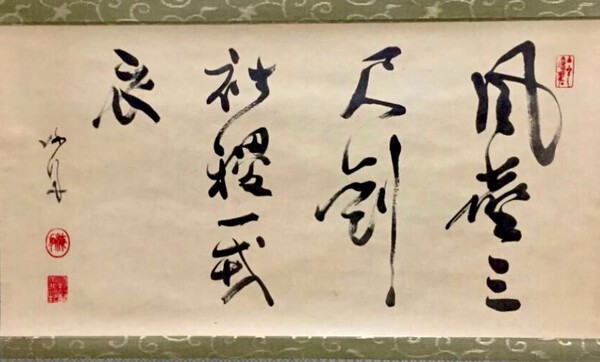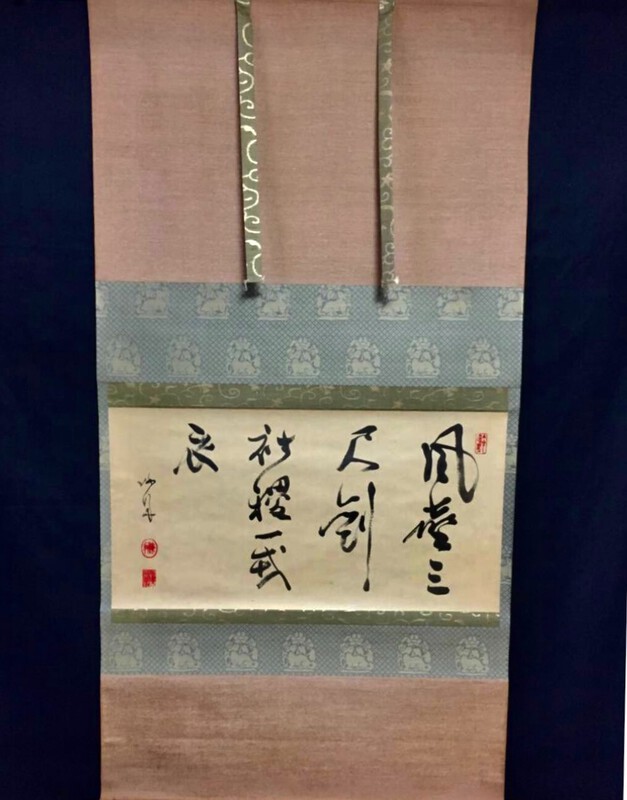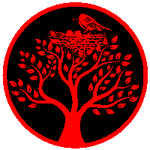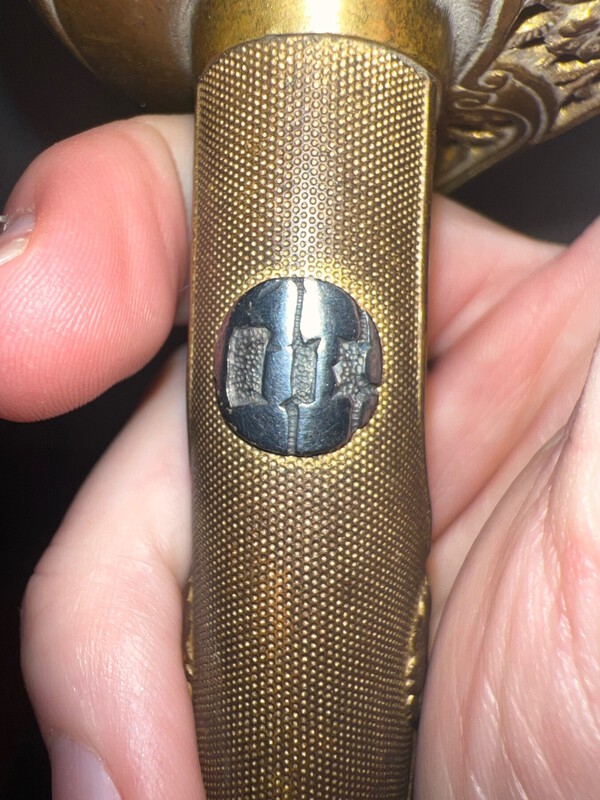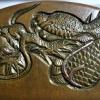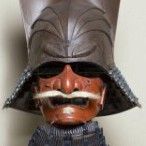All Activity
- Yesterday
-
I recently acquired this new kakejiku of a splendid calligraphy work by Katsu Kaishū that inspires my iaido practice. I just managed to finish the translation; the translation of the last 5 characters was not indicated on the accompanying kakejiku-bako. My wife recognized the two verses that Katsu brushed verbatim from historical Chinese poetry. Then it became a simple matter of obtaining that translation. Katsu Yasuyoshi (勝 安芳; 1823-1899), born Katsu Yoshikuni (勝 義邦), best known by his nickname Katsu Kaishū (勝海舟筆), was a Japanese statesman, naval engineer and military commander during the late Tokugawa shogunate and early Meiji period. An advocate of modernization and westernization, he eventually rose to occupy the position of commissioner (Gunkan-bugyō) in the Tokugawa navy and was a chief negotiator of the bakufu. As a major Tokugawa commander during the Boshin War, he is particularly known for his bloodless surrender of Edo to Imperial forces, which was co-negotiated with his compatriot and fellow calligrapher Yamaoka Tesshu. As a calligrapher, he is particularly recognized for his highly refined cursive script with examples including a pair of 6-panel byobu screens and individual calligraphic works, being well-versed in the Chinese classics, poetry, and the martial arts. In the work below, Katsu brushed two 5-character verses of "Revisiting Zhaoling" by the Tang Dynasty poet Du Fu (杜甫): "A three-shaku sword in the wind dust, a military uniform for the country" (風塵三尺剣, 社稷一戎衣). It expresses praise for the heroic role of the military in the birthing of a prosperous country, which is in keeping with the Japanese Bushido warrior culture. The imagery that Du Fu paints is of a great military leader expertly wielding a powerful sword to whip up "wind dust" (this is a very visual expression) and thereby produce the conditions of land and agriculture (i.e. "country") that founded the Tang Dynasty. There is a very masculine and martial sentiment in these verses. Du Fu's works came to be hugely influential in both Chinese and Japanese literary culture. Of his poetic writing, nearly fifteen hundred poems have been preserved over the ages. He has been called the "Poet-Historian" and the "Poet-Sage" by Chinese critics. A three-shaku (35.8 cm) sword is generally associated with the Odachi or Nodachi, a long and imposing weapon sometimes used on the battlefield (my practice katana are considered long at 2.45-2.5 shaku). They were also used in ceremonies, as symbols of status, or as offerings to deities. In Zhaoling, there is a monument to the exploits of the Tang dynasty military forces. From his childhood, Katsu learned swordsmanship from the famous teacher Otani Nobutomo. He also studied under Shimada Toranosuke, a skilled swordsman who influenced him by emphasizing Zen practice alongside kenjutsu. He studied at Ushijima Kofuku-ji temple in Tokyo. Kaishū held a license from the Jikishinkage-ryu Kenjutsu school.
-

Council
Rivkin replied to Pritajeni1's topic in Sword Shows, Events, Community News and Legislation Issues
What can I say, I also suffer from the temptation to discovery once in a lifetime treasure and it can be hard to accept I miss more often than land a score. -

Kobayashi Taigen, Zen Calligraphy of "Ichi" (一)
jawob replied to Iaido dude's topic in Other Japanese Arts
That's a bummer. Try the Museum of Fine Art Boston -
well hurry up and buy it hahahahah
-

Kobayashi Taigen, Zen Calligraphy of "Ichi" (一)
Iaido dude replied to Iaido dude's topic in Other Japanese Arts
I contacted John a while back to do the translation for a fee, but he seemed to get confused about it and sent me a translation for another work that was already published and previously translated. After that he stopped replying. Kushner Roshi also tried to contact him on my behalf, but that effort seems not to have been fruitful either. -
The plant depicted is 樅 - momi - Japanese fir. see: https://www.dropbox.com/scl/fi/gew1fwujq25us4bpahzst/FHJ.pdf?rlkey=xqwem1jg9d243ej1wmub7a0hr&st=l12r1vch&dl=0
-
Thanks. I'm trying to figure out if the last 2 kanji on my tanto could correspond to 吉日. I clearly see the 日, but the 吉 is less obvious. Could what can be seen be interpreted as part of the kanji that denotes 1308 or is all that information represented in the early characters? I see the 徳治 higher up for the era. I'm not sure what the 3 parallel lines denote and if an extra character is needed to complete the date. Not having a clearer image isn't helping.
-

Kobayashi Taigen, Zen Calligraphy of "Ichi" (一)
jawob replied to Iaido dude's topic in Other Japanese Arts
Steve, I'm probably stating the obvious but have you tried to contact John Stevens? -
吉日 it’s formulaic but 吉 = lucky/auspicious + 日= day
-
Big mistake...
-
I don't know why they come out as exceptionally low resolution. 40MP image, external link if needed - something we can work with. Unfortunately cell phone lenses also distort a lot so sugata is best photographed with the phone exactly in the middle - as an example sori in the first image and the last are different because the phone positioning is different. In the same way - high res photograph of the <activities>. Otherwise its a guess, especially since its suriage. I think there is yokote and your measurement was probably correct. Can be Muromachi can be something else, with better pictures one can try to estimate.
-

Kobayashi Taigen, Zen Calligraphy of "Ichi" (一)
Iaido dude replied to Iaido dude's topic in Other Japanese Arts
Hi Jeff. Yes, discovering Chosei Zen was a pleasant surprise. I have been trying to have a Yamioka Tesshu work translated and my research took me to Kenneth Kushner Roshi at Chosei Zen, whose Rhode Island sub-dojo of Chosei Zen practices Shodo as part of their Zen training. I also wrote to Zensho-an temple in Tokyo, which was founded by Yamioka in 1883, and which has a collection of his works. I have not heard back. The running cursive script is quite challenging to decipher, but I am undaunted. Having looked at hundreds of Yamioka's works, I am developing pattern recognition for his idiosyncratic, but also highly consistent brushwork. I am hoping to get lucky and stumble upon a work for which a translation is available and that points to a specific verse from well-known Chinese or Japanese Zen works. Zen masters even brush chapters from the Tao Te Ching. Then I can fill in the blanks. -
FlawfullWolf joined the community
-
Hello, My name is Wolf and I've recently come into possession of a Japanese Type-19 Kyu Gunto Cavalry sword and am having trouble finding the Mon on the handle, I have tried to find the Mon myself but have had little luck narrowing it down. Could I possibly have some help?
-
-
Don't need much, maybe 4cm x 3cm Let me know Cheers
-

Kobayashi Taigen, Zen Calligraphy of "Ichi" (一)
jawob replied to Iaido dude's topic in Other Japanese Arts
Outstanding works! Slowly trying to teach myself shodo, it is extremely difficult, especially attaining the right mental focus. Steve your link to Choseizen is very helpful to me -
Is this an authentic WW2 Japanese sword?
TroyUT replied to TroyUT's topic in Military Swords of Japan
Ok guys, I am going to return it. I know I’ve said it a hundred times but I cannot thank all of you enough for helping me out with this. I have learned more in the last day and a half of chatting with you guys than I ever knew before. -
From Markus Sesko Book: KIYOHARU (清春), Gentoku (元徳, 1329-1331), Suō – “Kiyoharu” (清春), “Bōshū-jū Niō Kiyoharu saku” (防州住二王清春作), Niō school, according to tradition the son of Kiyonaga (清長) KIYOHARU (清春), Hōtoku (宝徳, 1449-1452), Suō ` “Kiyoharu” (清春), “Niō Kiyoharu” (二王清春), Niō-school, according to tradition the son of Kiyozane (清真) KIYOHARU (清春), Ōnin (応仁, 1467-1469), Suō – “Kiyoharu” (清春), “Bōshū-jū Kiyoharu” (防州住清春), Kaifu group (海部), according to tradition this is the early signature of the Kaifu-smith Fusayoshi (房吉

